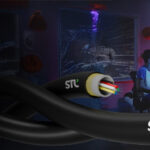
An illustrious building stood in the heart of the picturesque United Kingdom, nestled among ancient trees and grand architecture. This premier university is no stranger to innovation and excellence. Yet, despite the historic walls, there is always room for advancement.
Deep within the university’s hallowed halls, a Professor was poring over a stack of research papers, her brow furrowed in concentration. She envisioned seamlessly connected classrooms, laboratories, and libraries where data flowed like a river, aiding learning and research in previously unimagined ways. As Dean of the Information Technology Department, she had decided to take it upon herself that it was about time that the institute experienced the modern touch of technology. She had asked her staff to be on the lookout for potential partners in designing a best-in-class optical network infrastructure.
A key player in the same was the need for a partner to provide optical connectivity solutions to ensure stable connectivity with the end-to-end alignment of fibre ends. The search led them to STL, a leading optical and digital solutions company. STL’s reputation for technological excellence and commitment to pushing boundaries resonated deeply with the Professor. The university needed a suite of Optical Connectivity products that would enable them to access high-speed internet connectivity across the stretch of the campus and scale up the network deployment process. The requirement was for a solution that would ensure storage of fibre cable and splices to prevent them from being damaged or misplaced but at the same time store them in an organised manner, enabling flexible connectivity into network hardware.
Manufactured at STL’s state-of-the-art plant in Italy, the New Pivoting Tray Drawer (NPTD) HD was suitable for splicing and patching fibre optic cables. The rack (or case) structure of these drawers was 19” in size in metallic material with a removable front cover. According to requirement, the pivoting trays could be mounted inside, right or left. The NPTD HD trays offered the custom feature of being configured in both patch and splice-mixed mode. The sub racks were light grey RAL 7035, powder-coat painted. With the facility to be mounted on ETSI frames by using appropriate brackets, the university officials saw that the NPTD would be able to serve the dual purpose of splicing and patching as an integrated solution. Thus serving as a compact solution

With meticulous planning in place, the implementation phase commenced. The solution had been developed by STL in partnership with Networks Centre, UK’s leading distributor of end-to-end network infrastructure solutions. The teams worked tirelessly to install the optical fibre infrastructure across the vast expanse of the University’s campus. STL’s NPTD quickly found its place within the university’s ecosystem. The campus was soon buzzing with anticipation as technicians installed the trays with precision and care. It was no small feat, but their relentless dedication paid off as the university soon began experiencing the transformative impact of their efforts. Each NPTD had a story of its own – from the intricate wiring that ensured data transmission at lightning speed to the pivoting mechanism that allowed easy access for maintenance.

The university community was astounded by the transformation. Lecture halls now felt like portals to the digital age, allowing students to interact with experts from around the world in real time. Laboratories hummed with the symphony of devices exchanging data, facilitating collaborative research that transcended geographical barriers. Once a sanctuary of silent knowledge, the library became a hub of interactive learning with digitised resources accessible at the swipe of a finger.
This high-speed optical network connectivity brought a myriad of positive changes to the University. Research collaborations between departments flourished as data sharing and communication became seamless. Scholars across disciplines could now collaborate effortlessly, sparking new ideas and innovations. The positive effects rippled beyond the academic sphere, as the university’s administration witnessed a significant improvement in operational efficiency. Access to real-time data and streamlined communication systems allowed for better decision-making, further propelling the university’s development.
But it wasn’t just about technology. The optical connectivity network represented a bridge between the past and the future – a nod to the university’s rich history and its unyielding commitment to progress. The Dean, with a hint of nostalgia, often recounted stories of how the campus had transformed, drawing inspiration from the melding of tradition and innovation.

And so, in the heart of a premier university in the UK, where the echoes of centuries past met the whispers of an ever-evolving future, STL’s Optical Connectivity solutions would find a special mention for facilitating this confluence of technology and education.




